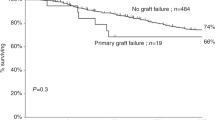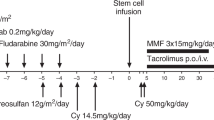Summary:
Haematopoietic stem cell transplantation (HSCT) represents the treatment of choice for severe bone marrow failure in patients with Fanconi anaemia (FA). When the donor is a compatible relative, the chance of being cured with an allograft is in the order of 70%. However, for FA children lacking an HLA-identical sibling, the results of HSCT from an alternative donor are less satisfactory because of a higher risk of graft rejection, graft-versus-host-disease (GVHD) and regimen-related toxicity. We report on a 12-year-old girl with FA, who was treated by T-cell-depleted (TCD) peripheral blood HSCT from her haploidentical uncle, using a novel fludarabine-based preparative regimen without radiation. She had rapid engraftment with no toxicity and no GVHD. Progressive recovery of both numbers of lymphocyte and of proliferative response to polyclonal activators occurred over time. At 18 months after transplantation, she is well with 100% donor chimerism and has recovered normal immune function.
This is a preview of subscription content, access via your institution
Access options
Subscribe to this journal
Receive 12 print issues and online access
$259.00 per year
only $21.58 per issue
Buy this article
- Purchase on Springer Link
- Instant access to full article PDF
Prices may be subject to local taxes which are calculated during checkout
Similar content being viewed by others
References
Auerbach AD, Buchwald M, Joenje H . Fanconi Anemia. In: Vogelstein, Kinzler KW (eds). The Genetic Basis of Human Cancer. McGraw-Hill: New York, 1997, p 317.
Butturini A, Gale RP, Verlander PC et al. Hematologic abnormalities in Fanconi anaemia: an international Fanconi anemia registry study. Blood 1994; 90: 105–110.
Gluckman E, Auerbach AD, Horowitz MM et al. Bone marrow transplantation for Fanconi anemia. Blood 1995; 86: 2856–2862.
Dufour C, Rondelli R, Locatelli F et al. Stem cell transplantation from HLA-matched related donor for Fanconi's anaemia: a retrospective review of the multicentric Italian experience on behalf of Associazione Italiana di Ematologia ed Oncologia Pediatrica (AIEOP)—Gruppo Italiano Trapianto di Midollo Osseo (GITMO). Br J Haematol 2001; 112: 796–806.
Guardiola P, Pasquini R, Dokal I et al. Outcome of 69 allogeneic stem cell transplantations for Fanconi Anaemia using HLA-matched unrelated donors. A study on behalf of the European Group for Blood and Marrow Transplantation. Blood 2000; 95: 422–429.
Davies SM, Khan S, Wagner JE et al. Unrelated donor bone marrow transplantation for Fanconi anemia. Bone Marrow Transplant 1996; 17: 43–47.
Berger R, Bemheim A, Gluckman E, Gisselbrecht C . In vitro effect of cyclophosphamide metabolities on chromosomes of Fanconi's anaemia patients. Br J Haematol 1980; 45: 565–568.
Gluckman E, Devergie A, Dutriex J . Radiosensitivity in Fanconi anaemia: application to the conditioning regimen for bone marrow transplantation. Br J Haematol 1983; 54: 431–440.
Fisher A, Friedrich W, Fasth A et al. Reduction of graft failure by a monoclonal antibody (anti-LFA-1 CD11a) after HLA nonidentical bone marrow transplantation in children with immunodeficiencies, osteopetrosis, and Fanconi's anaemia: a European Group for Immunodeficiency/European Group for Bone Marrow Transplantation report. Blood 1991; 77: 249–256.
Boulad F, Gillio A, Small TN et al. Stem cell transplantation for the treatment of Fanconi anaemia using a fludarabine-based cytoreductive reductive regimen and T-cell-depleted related HLA-mismatched peripheral blood stem cell grafts. Br J Haematol 2000; 111: 1153–1157.
Elhasid R, Weyl Ben Arush M, Katz T et al. Successful haploidentical bone marrow transplantation in Fanconi anemia. Bone Marrow Transplant 2000; 26: 1221–1223.
Locatelli F, Maccario R, Grossi P et al. Disseminated toxoplasmosis in a recipient of T cell depleted partially matched bone marrow transplant. Int J Ped Haematol Oncol 1993; 1: 247–252.
Stevens SJC, Verschuuren EAM, Pronk I et al. Frequent monitoring of Epstein–Barr virus DNA load in unfractionated whole blood is essential for early detection of post-transplant lymphoproliferative disease in high-risk patients. Blood 2001; 97: 1165–1171.
Comoli P, Labirio M, Basso S et al. Infusion of autologous Epstein–Barr virus (EBV)-specific cytotoxic T cells for prevention of EBV-related lymphoproliferative disorder in solid organ transplant recipients with evidence of active virus replication. Blood 2002; 99: 2592–2598.
Kohli-Kumar M, Morris C, Delaat C et al. Bone marrow transplantation in Fanconi anaemia using matched sibling donors. Blood 1994; 84: 2050–2054.
Giralt S, Estey E, Albitar M et al. Engraftment of allogeneic hematopoietic progenitor cells with purine analog-containing chemotherapy: harnessing graft-versus-leukemia without myeloablative therapy. Blood 1997; 89: 4531–4536.
Slavin S, Nagler A, Naparstek E et al. Nonmyeloablative stem cell transplantation and cell therapy as an alternative to conventional bone marrow transplantation with lethal cytoreduction for the treatment of malignant and non-malignant hematologic disease. Blood 1998; 91: 756–763.
Aker M, Varadi G, Slavin S, Nagler A . Fludarabine-based protocol for human umbilical cord blood transplantation in children with Fanconi anemia. J Pediatr Hematol Oncol 1999; 21: 237–239.
McCloy M, Almeida A, Daly P, Vulliamy T, Roberts IAG, Dokal I . Fludarabine-based stem cell transplantation protocol for Fanconi's anaemia in myelodysplastic transformation. Br J Haematol 2001; 112: 427–429.
Mac Millan ML, Weisdorf DJ, DeFor TE, Champagne MA, Auerbach AD, Wagner JE . Marked reduction in graft failure and regimen related toxicity after unrelated donor hematopoietic cell transplantation in patients with Fanconi anemia: impact of disease stage and Fludarabine. Blood 2001; 98 (Suppl 1): 670a.
Aversa F, Tabilio A, Velardi A et al. Treatment of high-risk acute leukemia with T cell-depleted stem cells from related donors with one fully mismatched HLA haplotype. N Engl J Med 1998; 339: 186–193.
Deeg HJ, Socie G, Schoch G et al. Malignancies after marrow transplantation for aplastic anemia and Fanconi anemia: a joint Seattle and Paris analysis of results in 700 patients. Blood 1996; 87: 386–392.
Zecca M, Prete A, Rondelli R et al. Chronic graft-versus-host disease in children: incidence, risk factors, and impact on outcome. Blood 2002; 100: 1192–1200.
Locatelli F, Giorgiani G, Pession A, Bozzola M . Late effects in children after bone marrow transplantation: a review. Haematologica 1993; 78: 319–328.
Rooney CM, Smith CA, Ng CYC et al. Infusion of cytotoxic T cells for the prevention and treatment of Epstein–Barr virus-induced lymphoma in allogeneic transplant recipients. Blood 1998; 92: 1549–1555.
Acknowledgements
This work was partly supported by grants from AIRC (Associazione Italiana Ricerca sul Cancro), CNR (Consiglio Nazionale delle Ricerche), MURST (Ministero dell’Università e della Ricerca Scientifica e Tecnologica) and IRCCS (Istituto di Ricovero e Cura a Carattere Scientifico) Policlinico S. Matteo to FL.
Author information
Authors and Affiliations
Rights and permissions
About this article
Cite this article
Rossi, G., Giorgiani, G., Comoli, P. et al. Successful T-cell-depleted, related haploidentical peripheral blood stem cell transplantation in a patient with Fanconi anaemia using a fludarabine-based preparative regimen without radiation. Bone Marrow Transplant 31, 437–440 (2003). https://doi.org/10.1038/sj.bmt.1703903
Received:
Accepted:
Published:
Issue Date:
DOI: https://doi.org/10.1038/sj.bmt.1703903
Keywords
This article is cited by
-
Successful HSCT using nonradiotherapy-based conditioning regimens and alternative donors in patients with Fanconi anaemia – experience in a single UK centre
Bone Marrow Transplantation (2005)
-
Fludarabine-based conditioning for allogeneic stem cell transplantation for multiply transfused patients with Fanconi's anemia
Bone Marrow Transplantation (2005)
-
Fludarabine, low-dose busulfan and antithymocyte globulin as conditioning for Fanconi anemia patients receiving bone marrow transplantation from HLA-compatible related donors
Bone Marrow Transplantation (2004)



